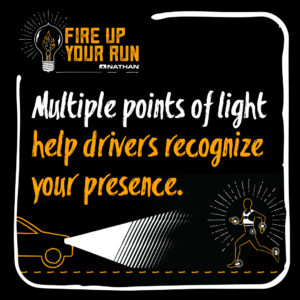How long does it take for a car to see you? Learn why your visibility plan is so important!
Car Safety
In the previous article on visibility, I opened with this remark: “Nothing ruins a great night run like getting hit by a car.” Biting humor aside, the comment bears repeating as safety during night runs is of immense importance. Allow me to elaborate. Big Peach Running Co. closes at 8 p.m. every Monday through Friday, so I’m usually driving home under the cover of dark skies and stars. Lately, I’ve noticed a casual cyclist riding down the opposite side of the divided highway. Thankfully, this rider has a headlight on the front of the bike, but that is the extent of the visibility. I didn’t see a rear light or any reflective strips on the clothing of the cyclist. This isn’t sufficient for safety purposes. This rider needs to incorporate more reflective gear to avoid being struck by an automobile. Speaking of which, cars are the focal point of this conversation.

Automobiles are consistently at the forefront of technological innovations. Front, side, and rear airbags are repeatedly tested and improved upon to protect the driver and passengers. Take a few moments to peruse the safety systems of three major companies. The Honda Collision Mitigation Braking System (CMBS) reduces the likelihood of a frontal collision with another car or a pedestrian by alerting the driver with an audible sound and application of the brakes. The Mercedes-Benz Night View Assist Plus uses infrared cameras to detect animals or people 160 meters ahead of the vehicle. Finally, the Audi Lane Assist alerts drivers through vibrations in the steering wheel if the car drifts towards lane markers. I have little doubt that these breakthroughs have saved lives, but this does not absolve runners from their responsibility to be evident to drivers, be it day or night.
Let’s recap a handful of the principles from the first two “Fire Up Your Run” articles. First, see and be seen. In other words, create a visibility package by way of active and passive lighting. Wear a neon colored shirt with reflective strips and don a headlamp or a flashlight. Add some strobe lights and reflective snap bands for good measure to showcase multiple points of light. Second, know the route you run, and develop a sense of what traffic looks like there at night. Is it still heavy or light? Is the route on a divided highway with an accommodating shoulder or a two lane road with little space to maneuver? Third, run with some friends if possible. More visibility gear means more lights and more recognition from oncoming traffic. Stick with the sidewalks and shoulder or join some other like-minded folks at your local Big Peach Running Co. for a weekly group run. That herd of runners will be glowing. Fourth, find a night race of some kind so the fun element is preserved. Running should always be rooted in play. On to reaction time.
Automobile collisions are typically framed up in the context of striking another car, but hitting a pedestrian is equally tragic. That said, what does the average stopping time of a car look like? Conventional thinking suggests that a car can go from 60 miles per hour to 0 in three seconds; research reveals that this figure is closer to 4 or 5 seconds. 6 seconds for a full stop is an even better number (which also accounts for initial reaction time). Needless to say, weather conditions and road conditions will affect this number too. Drivers and runners would be wise to tuck this information away. In short, leave space.
A final word on mobile phones. Driving at night is difficult enough with reduced visibility and mental fatigue from a full day’s work. Other tasks to be completed after arriving home are likely swirling through the mind as well. I recognize the need for an occasional phone call, but I urge you as a driver and as a runner who also drives to resist the impulse to send a text message, post a status update on Facebook, or scroll through the latest pictures on Instagram. In these moments, the eyes are off the road and the risk of collision with another vehicle or a cyclist or runner is exponentially elevated. Keep your peepers fully fixated on the road. Social media can wait until you arrive at your destination. I’ll add that like other drivers, I have a tendency to look at my phone at a red light. But I’m now choosing to disregard this inclination and instead keep my attention where it should be – on my surroundings. Set your phone aside during drive time.
In closing, automobiles and runners have a complex relationship. Both have valid claims to use the roads. Both have a responsibility too, the responsibility to observe traffic laws and pedestrian laws. These laws will not always be abided by, but the chief aim here is simple: safety. All in all, runners want drivers to arrive safely home from their evening commute; drivers want runners to still enjoy their exercise at night and return home safely too. Neither wish to collide with the other. Ruin is the result.
Austin Bonds is a Guest Advocate at the Big Peach Suwanee location.


